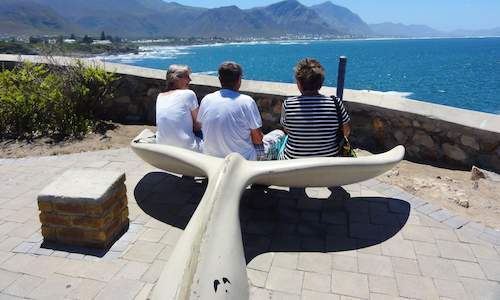Whale Watching in Hermanus
South Africa
Hermanus has grown from rustic fishermen's village to being acknowledged by the World Wide Fund for Nature (WWF) as one of the 12 best Whale viewing sites in the world.From its rocky cliffs, Whales can be seen as close as 5 metres (16.4 feet). It is also the only place in the world where one can watch the Whales and, by means of an underwater microphone, hear their calls at the same time.
The Southern Right Whales start arriving in Walker Bay from June and have usually left again by December. Peak Whale season, when sightings are virtually guaranteed on a daily basis, is during September and October. Calving season is in August and September and the Whale population peaks in Walker Bay during October.
The Southern Right Whale was so named because it was considered to be the right Whale to catch. The fact that it was rich in oil and baleen and floated when killed resulted in this slow-moving leviathan becoming one of the most hunted of all Whale species.
Today the Northern Right Whale is virtually extinct. There are an estimated 4 000 - 6 000 Southern Right Whales at present, with a large percentage visiting the South African coast annually. The Southern Right Whale can be distinguished from other Whales by its V- shaped blow and the callosities that appear on and around its head. The callosities are outgrowths of tough skin that form distinctive patterns on each individual.
Whales are large-brained and sensitive creatures. Strong bonds exist between females and their calves. In normal circumstances they are non-aggressive and gentle towards man.
Breaching
Breaching is when Whales lift their bodies out of the water in massive graceful leaps. Keep watching as they usually breach 3 - 5 times a session. Whales can push 3 quarters or more of their bodies out of the water and fall back into the sea with an enormous splash.
Spyhopping and Lobtailing
Spyhopping is when Whales lift their heads and part of their bodies out of the water vertically. This gives them a 360 degree view of the world above the water. Lobtailing is when they slap their tails on the surface producing loud claps. It may be a form of social communication or a warning to rival Whales or Sharks.
Sailing and Grunting
Sailing is when they lift their tails clear of the water for long periods. This could be means of catching the wind to sail through the water, or as a way of cooling down. Whales often grunt - a loud bellowing sound that is carried up to 2km (1.2 miles) away, at night.
Blowing
Blowing is a hollow, echoing sound made when air is expelled from the lungs through the blowhole, accompanied by a spout of water vapour. The shape of the spout enables watchers to identify the type of Whale.
Where can you see them?
The 12km (7.4 miles) long cliff path stretching from one end of Hermanus to the other provides the best terrestrial Whale watching vantage points in the world. In Hermanus you will find the world's only Whale crier. He patrols the streets of the town blowing his kelp horn and alerting everyone to the whereabouts of the Whales. Different horn codes refer to different spots along the coastline, where Whales have been spotted.
Windsor Bay
Park at Fick's Pool, the wagon wheels or in Marine Drive. In Marine Drive you can view Whales while sitting in your car.
Gearing's Point
A large gravel area offering views of Walker Bay to the east and west. The fishermen's paths leading to the rocks at the point are excellent vantage spots for Whale watching.
The Old Harbour
Above the Old Harbour there are old terraces with spectacular vistas across the bay. A telescope is available for a better view of the Dolphins or Whales, and situated alongside is a plaque bearing basic information on the Whales that visit Walker Bay.
Siever's Punt
This is one of the most rewarding spots for Whale watching. Whales are often seen in the bay between Mossel River and Voëlklip.
Kwaaiwater
One of the most popular spots for Whales is Kwaaiwater, where several viewing points are accessible by vehicle.
Voëlklip and Grotto
Whales are often found swimming just beyond the breakers at these beaches. While they do not swim in as close to the shore as they do in other areas, Whales are often seen breaching in this area and have even been known to surface under surfers waiting for a wave.

Hermanus, known as the whale watching town of the Western Cape, lies along Walker Bay on the south coast....
more
